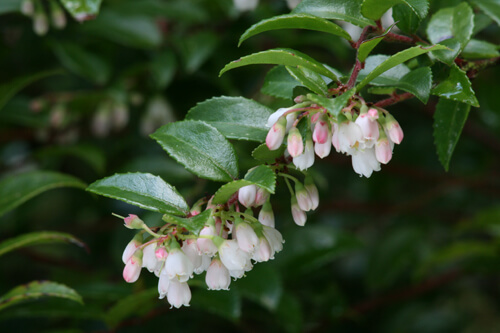
Evergreen huckleberry is a great choice for partly shady or sunny locations. A Northwest native, it is drought-tolerant and lovely in every season. © Richie Steffen / Great Plant Picks.
May is a great time to add plants to your garden that will thrive in dry weather. Every week you will find big plant sales, and nurseries are stocking a wide range of plants.
This week both the Master Gardeners of both King County and Snohomish County are having sales, along with the Lake Washington Institute of Technology, Tilth Alliance, Kubota Garden and more. Find out about more sales here.
Some options for drought-tolerant plants
There are many choices for attractive and versatile drought-tolerant plants. Many are Pacific Northwest natives. Some of our favorite native plants for partly shady areas are evergreen huckleberry (Vaccinium ovatum), vine maple (Acer circinatum), low Oregon grape (Mahonia nervosa), and sword fern (Polystichum munitum). Native plants have the advantage of providing food and shelter for birds, wildlife and beneficial insects.
For sunny areas, herbs and ornamental grasses are a great choice. Rosemary and lavender add fragrance as well as color. For grasses, consider maiden grass (Miscanthus sinensis), pheasant tail grass (Stipa arundinacea), and Mexican feather grass (Stipa tenuissima).
Even drought-tolerant plants need water
“Drought-tolerant” does not mean your plants will need no water. Every plant and tree will need regular watering for the first two or three years until the roots are firmly established.
After drought-tolerant plants are established, don’t assume that you can just turn the water off. In the summer, we tend to get very little rain. Most plants, including trees, will need some supplemental water over the season. You may be able to reduce watering to every other week or once a month in summer, especially if we get an occasional rainstorm that soaks the ground well.
As the climate changes, our summers are increasingly hot and dry. Last year we had a record-breaking 55 days without any rain at all. Our service technicians saw drought stress in a wide range of trees and shrubs.
Soaker hoses or drip irrigation are an efficient way to water deeply. Find out more about watering wands, hoses and sprinklers in this short video.
Water timers also make watering easier. You might consider a timer that turns the water on and off and on again, so it can soak in slowly and deeply. Find out more about timers in this short video.
Compost and mulch will help drought tolerance
Compost helps sandy soils to retain water in dry summers, and it helps clay soils to drain well in the wet winter months. Compost also enables plant roots to grow deeply, reducing the potential for drought stress.
Mulch is also important for drought tolerance. Mulch insulates the soil and helps it retain water. It also reduces weeds, helps prevent compaction from winter rains and feeds the soil. Good choices for mulch include compost, arborist wood chips, fallen leaves and coarse-textured bark. For details about types of mulch and their uses, watch this video.
Resources
- The Elisabeth C. Miller Library at UW Botanic Gardens has a great resource page for gardening during a drought, including plant lists, irrigation, mulch sources and more.
- Great Plant Picks has a list of drought-tolerant plants for sun.
- The Oregonian/Oregon Live has a long plant list and tips on managing hot, dry weather in the garden.
- The Natural Yard Care Program has a list of drought-tolerant plants.
- One of our recent blog posts talks about why plants need water to survive and thrive.
- Read last week’s blog post about how landscape watering is an investment that pays dividends.
- Our YouTube watering playlist has tips on how to water, including tools and techniques.
